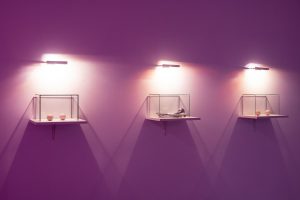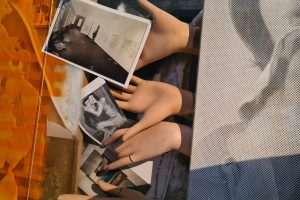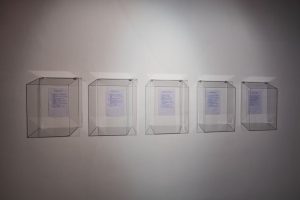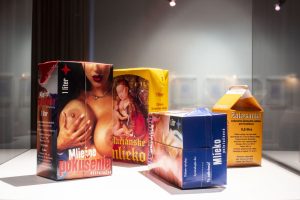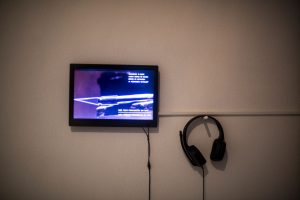The First Museum of Intermedia III (2021 ÔÇô )
Gentle force
Authors of works:
Jana ┼Żelibsk├í
Eva Filová
Anetta Mona Chi┼ča a Lucia Tk├í─Źov├í
Gabika Binderová
Lucia Dovi─Ź├íkov├í
Em├Âke Vargov├í
Dorota Sadovská
Veronika Rónaiová
Ladislav ─îarn├Ż
Exhibition concept and Curator:
Mira Sikorová-Putišová
Architecture and Visual Design of Exhibition:
Marcel Ben─Ź├şk
Exhibition is supported using public funding by Slovak Arts Council

Concept of the permanent display The First Museum of Intermedia always presents a new selection of works from the collection of intermedia and media art. (Intermedium: is of a hybrid nature, synthesizing elements of music, theatre, film, poetry. It includes forms of action art – performance, event, happening – as action forms of intermedia, and conceptual art. The static /and kinetic/ category of media is also referred to as new media ÔÇô installation, object, site-specific art or environment. Media art includes autonomous videos, video installations, video performances, experimental films recorded in analogue or digital, works of virtual reality, interactive digital works and internet art.). It is not a large collection of works, as many of them are space-consuming, so in the last two continuations of the project, thematic coverage has become decisive ÔÇô currently based on the category of gender, the perception of this category from women’ position and ÔÇô as an imaginary counterpart, from men’s. Now, nine years after the opening of the exhibition, the selected structure of the project, where the exhibition forms its dominant part, has proved to be the right direction. PMI is not “just” a display ÔÇô a collection of installed works with the relevant architecture of the exhibition space and the corresponding design, although at first glance only this part is visible. It also includes a guide to the display, a catalogue and a website (www.muzeumintermedii.sk), but above all ÔÇô its basis is a conceptual collecting activity.
The project of the permanent display draws attention not only to the context of the collection of works, but also to the provision of this activity. It is carried out almost exclusively from extra-budgetary sources, but installations and video installations are the most financially demanding works. If the amount of funds exceeding ÔéČ 100 000 spent on intermedia and media art purchases in the period 2017-2021 seems to be a high number, it should be noted that it was “spread” over five years and only as a part of the collection funds, which the gallery must expand [1].
The emphasis on architecture is necessary for this type of exhibition and the specifics of the space (small area) must also be considered. Together with the design of the display, it creates the so-called communication interface between the viewer and the work. Its elements are also the adjustment of works (plinths or plexiglass boxes made to measure for works), but the velvet curtain in powder and body hue has become the main feature. In addition to “softening” the sharp contours of the white-cube type of space, it is an important interior element in the intent of the exhibition’s theme ÔÇô especially in its ambivalence coded as Gentle (women’s) Force.
The works in the display combine the gender problematics and issues reflected by forms of media art and intermedia since the mid-1990s. Given the number of works, it is not an overview of the art of postfeminism, feminism and gender art after 1990 [2]. On the contrary ÔÇô the works in it are their samples and are presented in such a way as to reveal wider contexts: present at the time of their creation, also the position of the work as part of the artist’s work, but also within the mentioned tendencies. The works deal with ambiguities in the perception and viewing of the (female) gender, they touch on surviving gender stereotypes ÔÇô the so-called “gender role segregation” and their problematic context. The name of the display, set as a contradiction, is based on them and is a thematic umbrella of the works. It refers to the phrase ‘the weaker sex’, also used as an irony referring to of women’s physical and mental ‘equipment’, and emphasizes the inconspicuous resilience and perseverance with the connection of opposites of tenderness and strength as ‘fragile / female forces’, whether this is a real fact or a clich├ę. It is also a reference to the contents of terms such as “woman power” or “girl power”, which appeared in our art after 1989. The works in the collection are references to intimacy, privacy and various forms of communicating corporeality. The language individual artists goes from introverted expression, ironic perspective or sarcasm, to radically expressive speech. In the 1990s, the number of women artists reflecting on the schematic perception and depiction of women in visual culture (especially in advertising) increased significantly in Slovakia. Criticism of this schematism was undoubtedly an important but rather universal theme, and so the language and morphology of the works were similarly universal, especially in the case of the young generation of artists [3]. On the contrary ÔÇô in the zero years in the category of feminism and post-feminism, personal themes penetrated, the artist’s privacy was opened up and a more specific addressee was defined, – this factor is also demonstrated by the exhibition [4]. Compared to the 1990s, in the following decades the element of the so-called self-positioning” – defining the position: as the artist-mother / partner [5], in a broad sense also as part of the structures of the visual arts and artistic community, which they comment on from the position of women [6].
The First Museum of Intermedia III ÔÇô Gentle Force display is a continuation of a series of exhibitions held at the Museum of Art in ┼Żilina, which dealt with feminism, post-feminism and family art in Slovak fine art after 1990 ÔÇô especially Paradigm Woman a (in)time [7]. Although not targeted, the Gentle Force display is connected with the (in)time exhibition by the presence of a male counterpart [8]. Initially, as an (apparent) opposite, given by the opposite sex (in both exhibitions, except for the authors, women exhibited exclusively) can in both cases be understood as a form of “test of correctness”, which reaffirmed the aspect of gender and gender perception.
Mira Sikorová-Putišová
[1] Overview of Funds for Obtaining Works for the Collection of Intermedia and Media Art (1991 ÔÇô 2015): First Museum of Intermedia I ÔÇô II (2012 ÔÇô 2019), catalogue for the permanent display, p. 76. In the 1990s (1990-1997), works of intermedia and media art were obtained from the museum’s own budget in ┼Żilina, with an important minority segment being donations. In the years 2006 ÔÇô 2015 the museum covered purchases through the grant program Acquisitions of the Ministry of Culture of the Slovak Republic and since 2016 ÔÇô through subsidies from the Slovak Arts Council, volume of funds obtained since 2017: ÔéČ 95125 ÔÇô amount has been invested to purchase of twenty-two works. Two works of the amount of 5300 ÔéČ were purchased from museum’s own funds in 2017.
[2] Gender defines cultural environment, social relationships and interactions, so it is a more complex social and cultural construct, and it is not possible to determine it solely on the basis of different anatomical characteristics
[3] Exceptions in terms of the provable authenticity of the language are video installations and installations from the 1990s by Jana ┼Żelibsk├í and paintings by Veronika R├│naiov├í.
[4] It was defined as the art of radical privacy. More: Gregor, Richard: Authenticity, tradition and post-national situation. On development predispositions of Slovak visual art of the ÔÇ×zero yearsÔÇť. In: Sikorov├í-Puti┼íov├í, M. (ed): Zero years. ┼Żilina : Museum of Art, 2011, p. 123.┬á
[5] Gabika Binderov├í’s video reports on her position and work in the so-called institutionalized union, an aspect we call the marriage art. With Erik Binder, they were co-authors of several works on the subject of partnership at the beginning of the zero years. More: Klodov├í, L: Authentically lived stereotype ÔÇô a neglected phenomenon of marital art. In: Um─Ťlec 2005/1.
[6] For example, in the works of Veronika R├│naiov├í and Aneta Mona Chi┼ča and Lucia Tk├í─Źov├í.
[7]┬á The exhibition was part of the trilogy: Physical / Mental (1995), Paradigm Woman (1996), Between Man and Woman (1997), with concept by Katar├şna Rusn├íkov├í. They were linked by a gender attribute, and the exhibitions presented a masculine, feminine, and confrontationally feminine-masculine perspective. The following exhibited at Paradigm: Jana ┼Żelibsk├í, Ilona N├ęmeth, Petra Nov├íkov├í-Ondrei─Źkov├í, Denisa Lehock├í. More: Rusn├íkov├í, K.: Paradigm of a Woman. ┼Żilina: Museum of Art, 1996, p. 5.-13.
[8] The work of Ladislav ─îarn├Ż in the current display and the work of Vladim├şr Havrilla ÔÇô 10 minutes (1985) in the exhibition (in)time, interpreted as counterpoint by Lucia Stachov├í ÔÇô a male view of the exhibition motif, which was intimacy and revealing secrets. Exhibiting artists: Jana Bodn├írov├í, Pavl├şna Fichta ─îierna, Anna Dau─Ź├şkov├í ÔÇô Christina Della Giustina, Eva Filov├í, Aneta Mona Chi┼ča, Eva Masarykov├í, Elena P├Ątoprst├í, ─Żuba Sajkalov├í, Em├Âke Vargov├í. More: Stachov├í, L.: (in)time. In: Maz├║r, M. (ed): Museum of Art 2001, ┼Żilina: Museum of Art, 2001, unpaged. Morav─Ź├şk, M.: Her story. In: dart ÔÇô revue sou─Źasn├ęho umenia, 3-4 / 2001, p. 61-63.┬á

